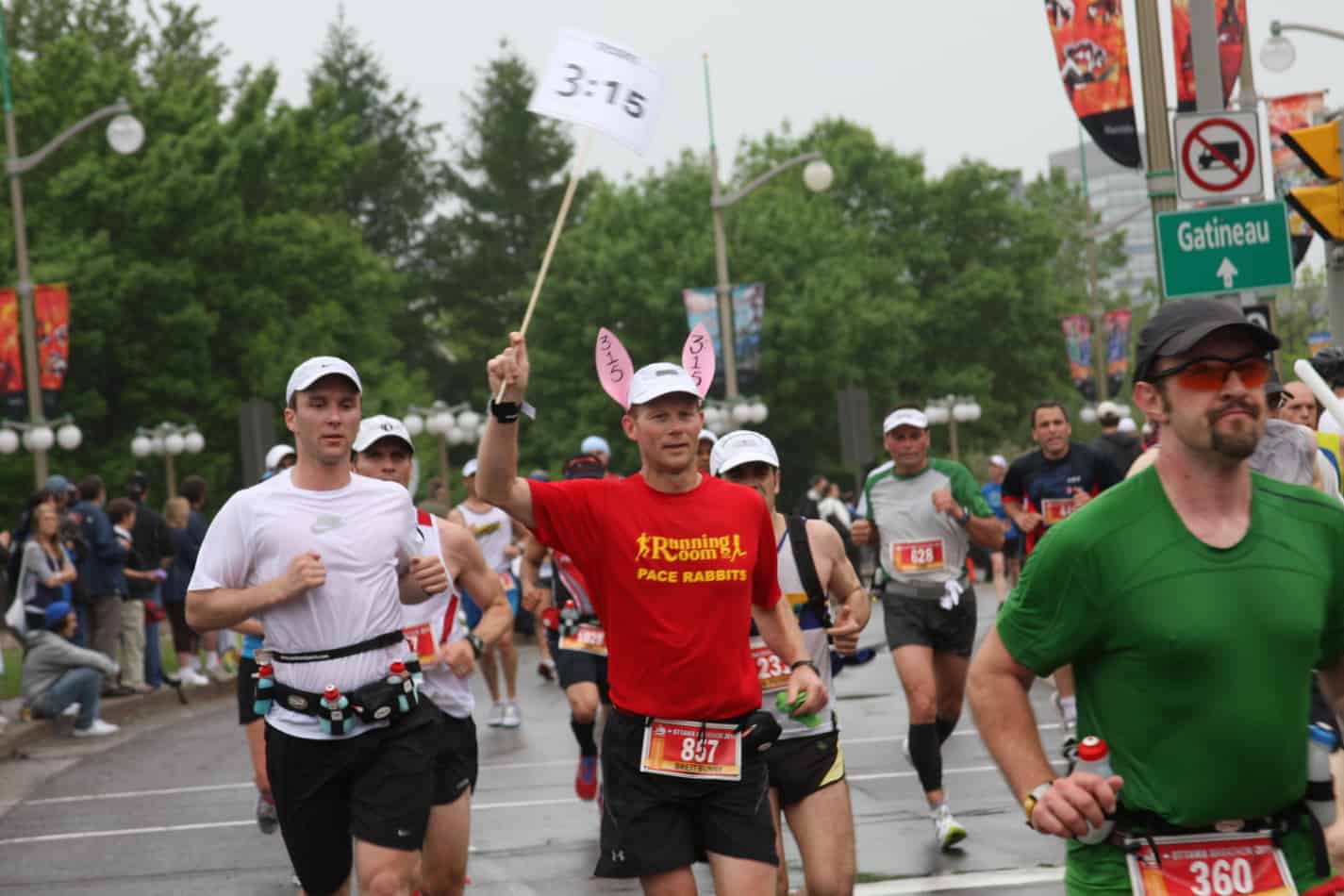Most runners who train for a marathon have a particular time goal in mind. Some new marathon runners may have a goal simply to finish, but even then it’s nice to have some idea of what time you’re training toward. Even if you don’t start your training with a time goal in mind, by the time you’re rounding out your long runs you typically have an idea of an attainable goal to shoot for. On the day of the race as you walk up ready as you’ll ever be, you see someone holding a sign with your goal time. Is that the marathon pacer? Should you go stand by them? Should you say hi?! That’s when you realize maybe you should have thought about this sooner and figured out exactly what their job is and how they can add value to your race.
So, what do marathon pacers do? Marathon pacers are usually volunteers who guide a group of runners to meet a particular goal pace. They generally hold a sign with the pace they are running written on it so they are easy to spot. With their expertise, they can help runners achieve their marathon goal time utilizing smart racing strategies.
Marathon Pacer Responsibilities
Marathon pacers, also sometimes referred to as “rabbits”, have an important responsibility to their runners. Not only are they expected to run the race applying smart racing strategies, but they are also looked to as someone who can offer encouragement to help runners cross the finish line in the time they hope to achieve. In a marathon, it’s often the negative thoughts in your mind that keep your body from getting through the toughest parts of the race and a pacer often can help you keep going even when you don’t think you have anything left to give.
Not every marathon offers pace groups led by a pacer, but many do. The Boston Marathon is one large marathon that doesn’t provide official pace groups, but you’ll find pacers at most larger marathons. Smaller marathons might be another time where there won’t be any pacers. Although the small marathon that I ran in Colorado Springs (221 runners) did have them.
Pacers are usually appointed to a time slot that is at least 15 – 30 minutes slower than their personal best marathon time. This ensures that the pacer is able to get its runners to the finish line under the goal time without issue.
Having a pacer to run with can be very helpful. But this also depends on your personality and how new you are to the sport. I’d recommend checking races you’re considering before you sign up in case that’s something you plan to utilize. Then weigh the pros and cons on whether to run with a pace group or not.
Deciding if You Should Run with a Marathon Pacer
Like many things in the running world, running with a pacer in a marathon is a personal choice. Although there are many great reasons to run alongside one, running your “own” race could work better for some runners. Here I’ll give you the pros and cons so you can determine how you’ll proceed when it comes time to run your marathon.

Pros of Running with a Pacer:
- Smart Racing Strategy – Marathon pacers are people who love to run and enjoy helping others achieve their goals. They have experience in the marathon distance and understand what it takes to achieve a specific goal time. Understanding that not all parts of a marathon are the same in terms of effort is an important part of a pacer’s job. They are able to guide runners more conservatively in the beginning of the race in order to ensure they have more energy and strength for later in the race when they need it. Good pacers will also guide their runners to run a slower pace up hills and then quicken their pace to gain that time back on any downhill stretches. One big mistake of new runners is that they go out to fast. Pacers do a good job of helping runners hold back in the beginning and then pick up the pace later on.
- Strength in Numbers – There is definitely value in running in a group. If you start with a particular set of runners who have the same goal as you, it can be an added push for you to continue to stay with them and achieve your goal together. Extroverts will probably love this aspect of pace groups – being able to share your joys and struggles through the race with others can be just the encouragement each of you need to make it to the end without falling behind your goal.
- Words of Encouragement – Not all marathon pacers are going to chatty, but I think generally these runners love the running atmosphere and want to see its group of runners achieve their goal. They’re also typically people who already run with groups and are probably used to holding conversations as they run – especially at a pace that’s significantly below what they would normally run in a race. The positive for you is that they can talk to their runners throughout the race to offer encouraging words and give tips to runners if they are feeling discomfort, etc. One runner who I follow on Instagram attributed much of her Boston Qualifying race to the support from her pacer – as other runners fell behind she stuck with him and he never let her lose sight of her goal time. He continued to remind her to keep pushing through the pain to the very end.
Cons of Running with a Pacer:
- Not All Runners are Created Equal – The idea of a pace group is that they will either run pretty even splits the entire race, or they will account for hills where they will slow down and then shave some time off later. Unless you have the ability to talk to them ahead of time at the Expo or prior to the race, you may not know which strategy they plan to utilize. And this could be different than the way you trained. Maybe you have negative splits in mind and they don’t. Or there might be a mile where you need to relax a bit more to shake out some discomfort when they won’t need to slow down. Not all runners will achieve a goal time in the same way, but if you choose to run with a pacer then you will all run the course in a similar way throughout.
- Added Pressure – If you choose to run the marathon with a pacer, you might be putting extra pressure on yourself to stay with them the entire time even when it’s not in your best interest. Maybe you need to cut back and grab water, but then you feel pressure to catch back up. While this may seem fine because you’re maintaining the pace that way, pushing yourself to quickly catch back up can hurt you more than you’d realize by unnecessarily overexerting yourself.
- Wrong Pace Group – Although you might have a pace in mind that you’d like to achieve, it might not be the pace that you really trained for. In 2017 when we ran the Twin Cities Marathon, my husband and I went back and forth on if we should run with the 3:40 pacer because that’s the time we really wanted. But we both knew that 3:45 was more closely aligned to what our training had prepared us for. We ended up deciding not to run with a pacer at all. Had we jumped in with the 3:40 pacer I know we would’ve gone out to fast. This likely would have made us hit a “wall” too soon and we ultimately would’ve ended up with slower times than we did.
![Katie Chan [CC BY-SA 4.0 (https://creativecommons.org/licenses/by-sa/4.0)] Member of the Runner's World Pace Team](https://readysetmarathon.com/wp-content/uploads/2019/06/London_Marathon_2014_-_Runners_World_Pace_Team_02-1024x683.jpg)
FAQs about Marathon Pacers
Do I have to talk to my marathon pacer? Hopefully, your pacer will be friendly and acknowledge you. Though this kind of depends on the size of the pace group. Once you’ve exchanged “hellos”, it’s mostly up to you how much talking you want to do with your pacer. It’s possible they’ll be extra talkative and want to talk with you to pass the time, but if you prefer not to you can always hang back a bit. Just because you choose to run with a pacer doesn’t mean you need to hold a conversation while you race.
Will I be with the same pacer the entire time? You will probably run with the same pacer the whole time. Some marathon pace groups will have a pair of pacers for each time goal – probably to ensure accuracy and that the pacing goes according to plan. I have also heard of pacers who will run the first half marathon and then a second marathon pacer jumps in for the second half. This is something good to know about your particular marathon ahead of race day.
Why would a marathon pacer volunteer their time to do this? Marathon pacers love to run and enjoy the racing atmosphere. Though they do love helping others reach their goals, they also get a free race entry and maybe some other free swag. Some faster pacers may get monetary compensation, but this is pretty rare.
What happens if I can’t keep up with my pacer? If you join a pace group and at some point during the race decide you can’t keep up with your pacer or that it isn’t in your best interest to stay at the pace they’re running, then just slow down. You can always jump into a slower pace group as they come upon you during the race if that happens. Don’t stress about it – just be smart about your own race and your personal limits. Just because you start in a pace group doesn’t mean you have to stay with them.
What if my pace group ends up feeling too slow for me? No problem! You can always decide mid-race to pull away if you’re feeling like you can handle the jump in pace. You can look ahead to the next pace group if you decide that’s the best course of action for you. I will caution you, however. Your pacer should know what they’re doing and if they start out slower than the split pace you planned on for your goal marathon time, chances are this is in your best interest. Staying with them until at the least the halfway mark is a good rule of thumb. If you’re still feeling good, then you can quicken the pace. Be careful to not go out too fast, because it will cost you big time toward the end of the race.
What happens if my pacer can’t keep up the pace? Some marathons will have a pair of pacers who lead the group together for this very reason. But some marathons will only have one. Even the best runners have bad days, and a pacer could, too (especially a runner who may be new to pacing). Though this is unlikely to happen, I highly recommend being flexible in case the pacing doesn’t go according to plan. You’re the one who’s done the hard work to prepare for a particular marathon goal time anyway; don’t get discouraged if the pace group idea doesn’t work out perfectly. Just run your own race at that point and know that you have the strength to do it completely on your own!
Word to the Wise about Marathon Pacers
I think pace groups can be highly beneficial for all of the reasons listed above. Experienced pacers who strategically run the race based on effort with a conservative starts (as opposed to even splits the entire time) can really help a newbie marathoner who may not understand how to go about this type of pacing. But I also caution you to do your homework, too, by following these steps:
- Train for an appropriate goal. Although your marathon goal time should challenge you, it also needs to be attainable. Utilizing this calculator from McMillan Running is a great way to establish a personal marathon target. Then, be sure your training matches this goal or adjust accordingly.
- Find your race. Determine if your race has pace groups and reach out to the coordinators if you can’t find specifically how the pacers plan to go about running the race. Having this information ahead of time will help you determine if you want to use a pace group so you won’t be having to make a last minute decision at the race.
- Go to the Find My Marathon Pace Band page. Find your marathon and then enter your goal time with a start strategy of “conservative start” and a pacing strategy of “even effort”. Looking over these split times is a great way to prep yourself to race smart. Having this as a back-up plan even if you run with a pacer is a great idea.
- Decide if you’ll run with a pace group. If you do decide to, make sure you chat with them ahead of time as you’re waiting for the race to begin. Establishing a rapport with them while also understanding their race plan will prepare you to have a great race.
- You do you. If you need to change things mid-race then do it! This is your race and your race only. Ultimately the only one you can count on to do your best is yourself. By planning with purpose and running smart, you’ll be sure to have a great race!







